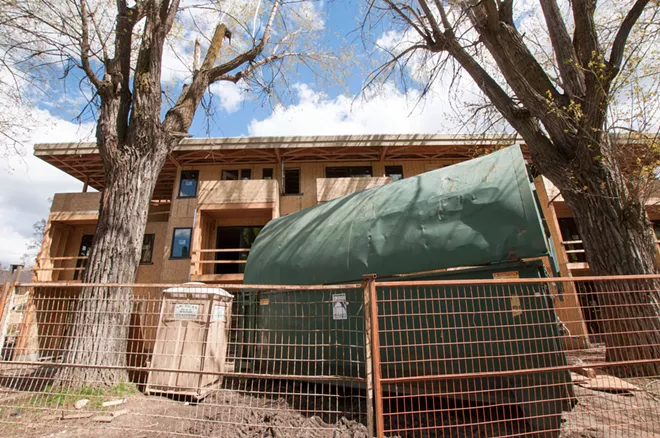
Daniel Walters photo
These townhouses under construction on Chestnut and Second Avenue have become an example, cited by the Browne's Addition Neighborhood Council, as to why the neighborhood needs a demolition ban.
Housing developers looking to tear down and build up in the Browne’s Addition neighborhood will either have to look elsewhere or sit tight for the next six months.
On April 10, the Spokane City Council unanimously voted in favor of an emergency moratorium — and a six-month extension at Monday's meeting — on demolition permits for Browne’s Addition after multiple properties have been torn down. Most recently, a house at 201 S. Chestnut St. was demolished and is being replaced with a multi-family residential complex, contributing to the neighborhood council's decision to request the moratorium.
While the moratorium is in place, the city plans to review current demolition regulations, and the Browne’s Addition Neighborhood Council will work to complete an application for historic neighborhood status.
Councilmember Lori Kinnear sponsored the anti-demolition ordinance and pushed to add more support of historic preservation to the city’s budget priorities for
“While we want infill, we don’t want to destroy what we have in our city,” Kinnear said at Monday's City Council meeting.
Rick Biggerstaff, Chair of the Browne’s Addition Neighborhood Council, says it is important to protect neighborhoods’ personalities. He pointed to Perry and Kendall Yards as examples of neighborhoods with contemporary personalities, and Browne’s as one with a more historic personality.
“When you enter our neighborhood, you go back in time,” Biggerstaff says.
Browne’s Addition residents understand that not all of their properties are perfect, he says, but they care about what they have.
“We buy these properties knowing we are going to get our elbows greased and our hands dirty,” Biggerstaff says.
He says the neighborhood does not oppose new housing and
Biggerstaff says he was particularly disappointed to see the loss of open, green space at the Chestnut Street address when demolition finished and construction began.
Asher Ernst is developing the Chestnut Street lot into two townhouses with his business partner, David Sloan. Ernst says he and his wife moved into the neighborhood to be close to Roosevelt Elementary, where his wife helps kids from other countries learn English. He says the house that was on the lot would have cost hundreds of thousands of dollars to restore.
“We tried to keep that building, but there wasn’t a way that made fiscal sense,” he says.
Urban neighborhoods are constantly changing, Ernst says. The townhouses, which he hopes to move into in August, were designed with contemporary Northwestern architecture in mind and he believes that they would complement the neighborhood well. Ernst, who used to be on the city's Plan Commission, says he has received positive feedback from people in the neighborhoods, and was surprised by the Neighborhood Council’s reaction.
"People are more important than buildings.” — Developer Asher Ernst, on balancing the desires of neighbors and developers in Browne's Addition
Despite the disagreements, Ernst says, he looks forward to moving in and being an active member of the neighborhood.
“Our ideal outcome is we just want to be friends and neighbors with folks,” Ernst says. “We just want to be friends with people, even if they don’t like our building. People are more important than buildings.”
Megan Duvall, Historic Preservation Officer, says getting the neighborhood on the Spokane Historic Register would give the public more of a say in what happens to the buildings, but it could not entirely stop demolition and development. Currently, Duvall says, the city can only reject a request to demolish a building in Browne’s Addition if the developers plan to replace it with a surface parking lot.
“If they want to replace (a property) with a new building, we have no avenue to stop that,” she says.
The Corbin Park historic district, made up of 88 properties, is the largest neighborhood on the Spokane Historic Register. Browne’s Addition encompasses more than 300 properties; Duvall estimates that about 200 to 250 of them would be designated as significant contributions to local history.
“It would be huge. It is a huge task,” she says.
Despite not being on the Spokane Historic Register, the neighborhood has been on the National Historic Register since 1976, but Duvall says that is mostly an honorary designation. Back then, she says, the neighborhood faced similar challenges, with housing developers seeing a ripe opportunity to build in an appealing area near downtown. Now, hundred-year-old residences are mixed in with mid-century apartments and houses built in the ’70s.
“There is always a push and pull,” Duvall says. “Especially in a place like Browne’s.”
Jessica Kettrick and her husband, Jason, owned property in Browne’s Addition for about 15 years before they decided to tear down the two buildings on it and build an apartment complex.
Kettrick says she considered restoring the buildings, but they were in bad shape. She had always dreamed of developing the property.
They met with the neighborhood council to answer questions and discuss concerns, she says, but residents worried throughout the process.
In June 2016, the 21-unit complex at Third Avenue and Coeu
Kettrick says she loves the socioeconomic diversity and “artistic vibe” of Browne’s Addition, and says there are a lot of properties in the neighborhood worth preserving, but some of the lesser-maintained buildings could better serve Spokane families as new housing options.
“I hope everybody is open to change and progress,” Kettrick says, “and can figure out a solution where everyone can be proud of their neighborhood.”
